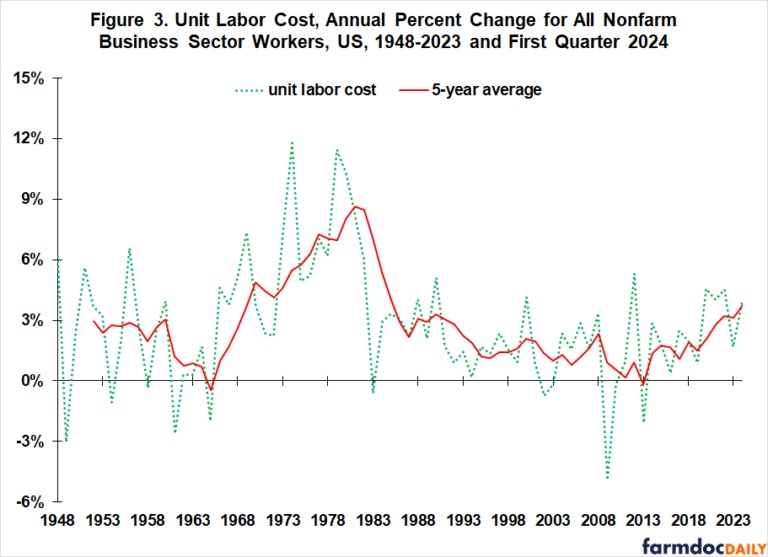By Carl Zulauf
US labor productivity and cost are examined given the on-going discussion of labor’s role in current US inflation. Each measure used in this study has high variability, even on an annual basis. Short term changes should thus be viewed with caution. The rate of increase in nominal (i.e. not adjusted for inflation) cost of US labor has been increasing since 2015. It is higher now than at any time since the late 1980s. Moreover, no long-term upward trend exists in US labor productivity. Caution is thus in order when speculating that the increasing cost of US labor is a temporary event and that artificial intelligence will increase US labor productivity and dampen its cost. Variability of these widely-followed measures is high enough that it would be useful to investigate if changes can be made to the data generation process to reduce their variability.
Labor Productivity
Source for the data used in this article is the Federal Reserve Bank of St. Louis data (FRED). FRED’s data on labor productivity in the US nonfarm business sector starts with 1948.
US labor productivity, as measured by output per worker for all US workers, has increased on average by +1.9% since 1948 (see Figure 1). Despite considerable discussion of the impact of electronic and digital products and services on labor; no upward trend in the growth rate of labor productivity is evident. The growth in labor productivity may however have slowed without the advances in these products and services.

Year-to-year variability in labor productivity is striking. Annual percent change ranges from -2.6% to +8.8% with spikes up and down common. This variability suggests any individual year change, let alone data less than a year in length, should be viewed with caution. A multiple year average is likely to be a more reliable measure. Figure 1 includes a 5-year moving average.
Hourly Compensation
A well-established relationship is that growth in labor productivity translates into higher compensation for labor. Given no long-term upward time trend in the growth rate of labor productivity, it is therefore not surprising that no long-term trend exists in nominal hourly compensation (see Figure 2). An upward trend has however existed since the middle of the last decade. The 5-year average is now 4.5%-5.5% instead of 2,0%-2.5%. It is now similar to the 4.9% average annual increase since 1948, but remains well below the 8.5%-9.5% 5-year average increases of the late 1970s and early 1980s. As with labor productivity, year-to-year variability in nominal hourly compensation is high.

Unit Labor Cost
Unit labor cost is a measure of labor cost that takes labor productivity. Into account. Since 1948, nominal unit labor cost has increased on average by 2.8% per year. Again, year-to-year variability is high. As with hourly labor compensation, growth in unit labor cost has increased since the middle of the last decade. The 5-year average is now 3%-4%, its fastest rate since the mid-1980s.

Summary Observations
The growth in the cost of US labor has been increasing since 2015, even after taking changes in productivity into account. The length of this upturn suggests increasing labor cost is not a temporary event but, at least in part, reflects longer term factors. The January 6, 2022 and January 11, 2023 farmdoc daily examine longer term factors, including labor force participation rates and retirement of the baby boomers.
Lack of an upward trend in the productivity of US labor since the end of World War II suggests caution is in order when speculating that artificial intelligence will increase overall US labor productivity. As with other electronic and digital products and services, the need for support personal dilutes advances in labor productivity. Artificial intelligence is more likely to impact labor cost and productivity in some individual sectors rather than the US economy as a whole.
Each measure of labor cost and productivity examined in this study is characterized by high variability, even on an annual basis. Short term changes in these widely-followed measures should be viewed with caution. Longer-term averages are likely to be more informative. Variability is high enough that it would be useful to investigate if changes can be made to the data generation process to reduce their variability
Source : illinois.edu